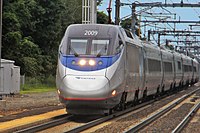
Photo from wikipedia
Abstract Extensive investigations, within the EUROfusion Work Package "Tritium, Fuelling and Vacuum", indicate that sufficiently deep fuel deposition inside H-mode plasmas of the EU-DEMO tokamak requires injection of fuel pellets… Click to show full abstract
Abstract Extensive investigations, within the EUROfusion Work Package "Tritium, Fuelling and Vacuum", indicate that sufficiently deep fuel deposition inside H-mode plasmas of the EU-DEMO tokamak requires injection of fuel pellets from the High Field Side (HFS) at speeds ≳ 1 km/s. To implement this, two different approaches are being pursued: one makes use of “conventional” curved guide tubes, featuring large bend radii (≳ 6 m), to transport 1 km/s pellets to the HFS while trying to preserve their mass and integrity; the other explores the feasibility of injecting high-speed (≳ 2 km/s) pellets from the HFS, along "Direct-Line-of-Sight" (DLS) paths. This paper focuses on the latter approach. Recent tests with an existing ENEA-ORNL high-speed injector have confirmed that the trajectories of free-flight pellets, travelling under vacuum at speeds up to 2.4 km/s, spread within an angle ≲ 0.68°. Despite their small scatter cone, free-flight pellets may require too much cut off volume of the Breeding Blanket (BB), due to the large distance between the injector and the plasma. The introduction of a straight DLS guiding tube transporting the high-speed pellets, to avoid significant loss of BB material, has been investigated. The existing ENEA-ORNL injector has been modified to accommodate a 10 mm i.d. DLS guide tube, and intact pellets have been consistently delivered downstream of the guide at speeds up to 2.6 km/s, with remarkably reduced scatter cone, thus showing the viability of this innovative approach.
Journal Title: Fusion Engineering and Design
Year Published: 2021
Link to full text (if available)
Share on Social Media: Sign Up to like & get
recommendations!